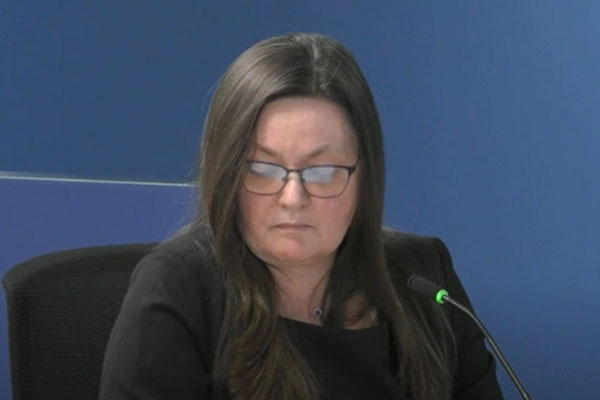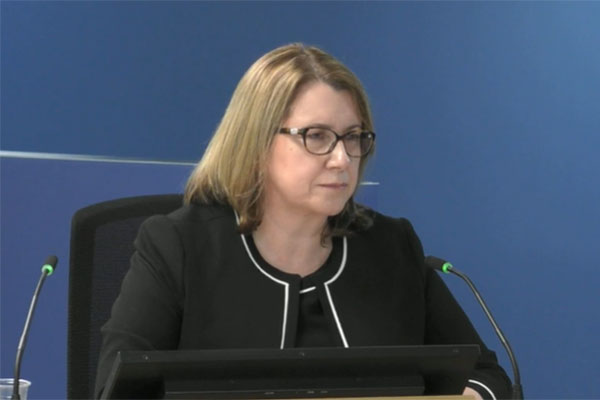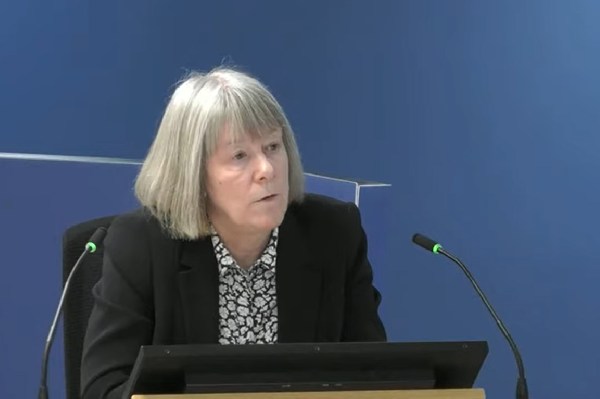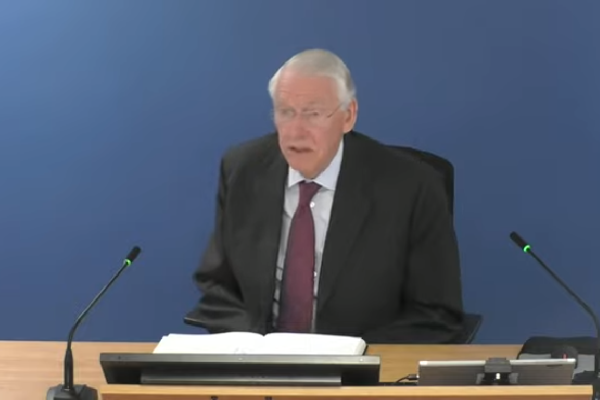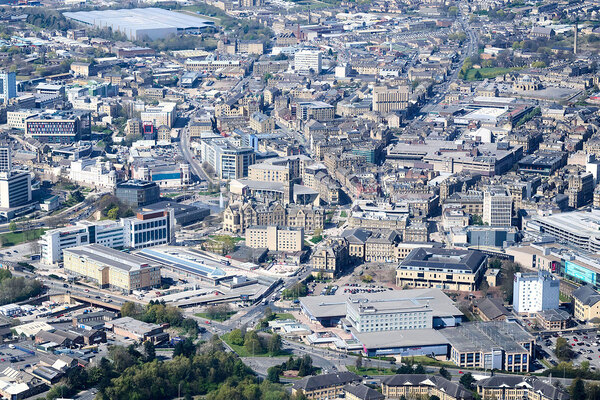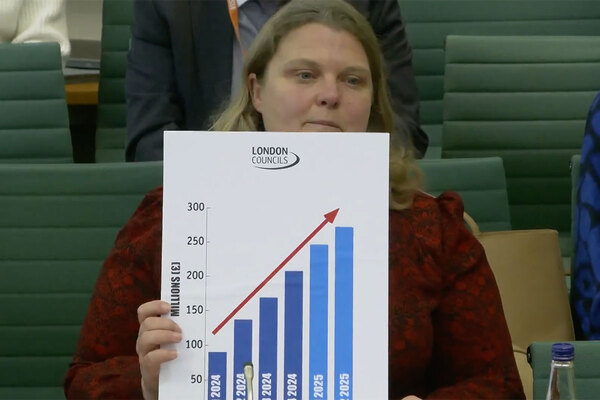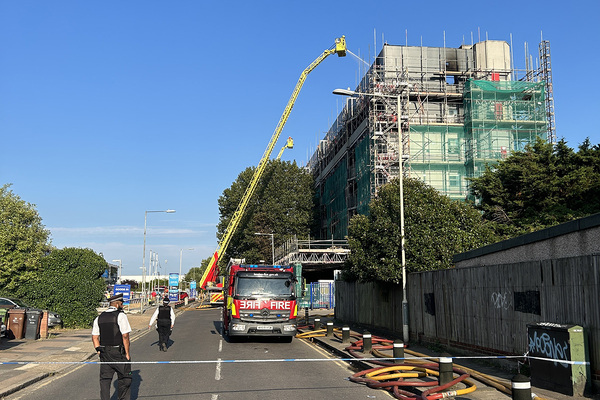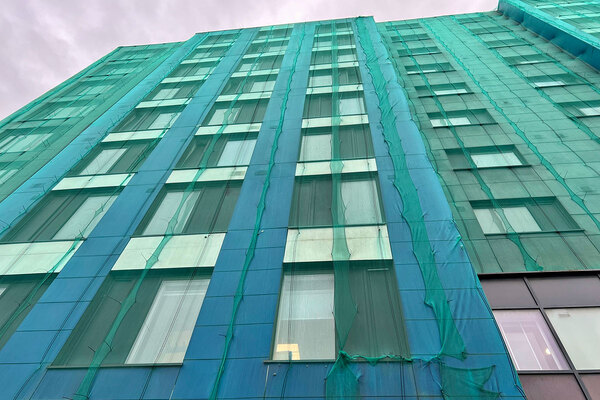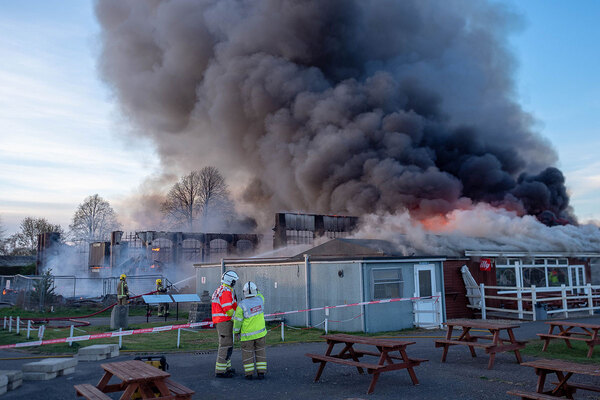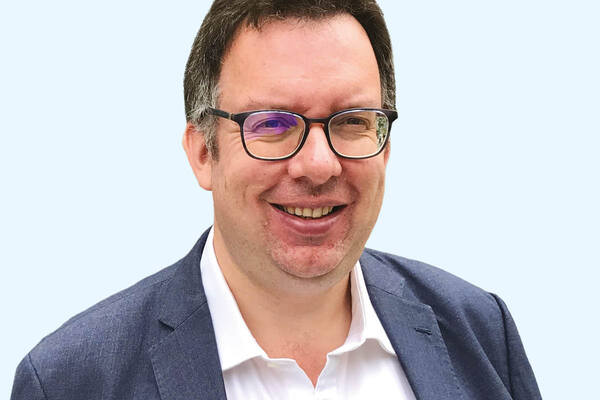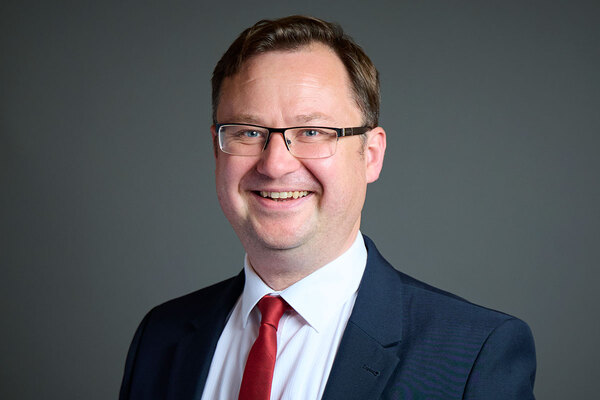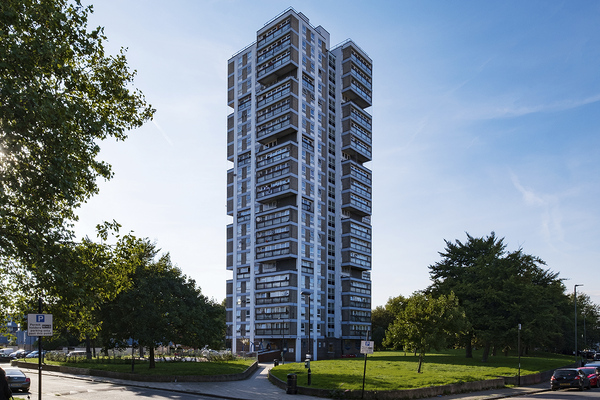Grenfell Tower Inquiry diary week 64: ‘I didn’t think ACM would be suitable for use in any high-rise buildings. I don’t think anyone did’
This week, the Building Research Establishment’s Dr Sarah Colwell gave more than three days of evidence, with some huge revelations about what was known about the dangers of aluminium composite material (ACM) years before the fire and the mass confusion over the government’s building regulations. Peter Apps and Jack Simpson report
What is Class 0?
It is necessary to begin with a quick explanation of a fire standard which was at the heart of much of this week’s evidence: Class 0. Technically, this standard is achieved by a material which passes two tests set out in a British Standard.
There have long been concerns about how reliable it is. In brief terms, the tests primarily assess the performance of the surface of a material, and some highly combustible products can obtain it.
Building regulations guidance for England and Wales, contained in the government publication Approved Document B, said that “external wall surfaces” of tall buildings needed to meet this standard. This was taken to mean that cladding panels with this classification were acceptable under our rules.
This week we heard how, for 30 years before the Grenfell fire, warnings that this standard was too low and risked disaster were repeatedly missed.
‘Can we agree that the clear inference of that paragraph is that this was a non-combustible system?’
The story began with a fire in 1991 at a block in Knowsley Heights, Merseyside.
This fire has long been talked about as a staging post in the story of the cladding crisis in the UK. We explored it in detail here.
The building was a pilot scheme, funded by the government to test the efficacy of cladding as a means to insulate council tower blocks. It was being monitored by the government and the Building Research Establishment (BRE), the testing and research facility that was part of the British state until it was privatised in 1997.
The fire, which had ripped up all 10 floors of Knowsley Heights and was affecting the roof by the time the fire service arrived, could have been a major alarm bell of the potential for disaster associated with cladding.
It was not, and our previous investigation revealed a handwritten note suggesting a desire to “play down” the fire.
This week, the inquiry considered something different: the combustibility of the materials on the tower.
Many in the industry understood Knowsley to have been clad with non-combustible materials. They believed the blaze spread because of the unprotected cavity between the external cladding panels and the insulation. Indeed, a new requirement to put barriers into this cavity was the only regulatory change following the fire.
The BRE’s report into the fire, revealed by the inquiry this week, showed that the cladding panels were glass reinforced plastic (GRP). They possessed a Class 0 rating and were combustible.
But the BRE’s report made no significant issue of this. In fact, it said a few paragraphs later that cavity barriers were not fitted and noted that “under [official] guidance at the time [cavity barriers] could be omitted where the cladding system was non-combustible”.
“Can we agree that the clear inference of that paragraph is that this was a non-combustible system, otherwise why would that sentence read as it does at the end?” asked Kate Grange QC.
“I’m sorry, I can’t speak for what the authors were suggesting with that,” replied Dr Colwell.
The same description was used in a summary report of major cladding fires, produced by the BRE in 2016, which Dr Colwell was listed as having signed off. She explained this by saying it simply followed the original report, but did not endorse it.
The 2016 report listed several potential factors for the rapid spread, but omitted any mention of the combustible cladding.
Asked if she felt the panels should have been added to the list of factors which “caused the fire to propagate from the base of the tower to the roof within minutes”, Dr Colwell said: “Given that GRP was combustible, it could have been highlighted, yes.”
‘It is clear… that a cladding material achieving a Class 0 rating may suffer extensive surface burning’
Following the Knowsley Heights fire, the BRE began to work on a large-scale cladding test which would ultimately become the BS-8414 system test the inquiry has heard so much evidence about in the past.
This research involved running a series of large-scale tests at its research facility in Cardington.
This research plainly identified the problem with Class 0 cladding. The report prepared by Dr Raymond Connolly said: “It is clear… that a cladding material achieving a Class 0 rating may suffer extensive surface burning. This burning often spread to the top of the test building (some 9 metres) and would have spread further if possible.”
“In the light of this report, did you at any stage consider the reliance in Approved Document B … on [Class 0] to be a matter that needed to be addressed?” asked Ms Grange.
“Yes,” Dr Colwell replied. “The pick-up from what I was being told and had been explained to me suggested that that was what was going to be addressed, because they had found evidence that it wasn’t appropriate.”
But a further opportunity to make this point came and went. In 1999, there was a fire at Garnock Court in Irvine, Scotland. This blaze also spread through glass reinforced plastic panels to the top of the block. The BRE was commissioned to report on it for both the government and North Ayrshire Council, which owned the tower.
The report to government was clear that the blaze was a consequence of the panels. “The plume will have ignited the GRP and remained in contact with it and generated a self-propagating fire,” it said.
But it contained no reference to the fact that these panels were supposed to be Class 0.
“Did you notice that the report was silent on whether or not the panels had achieved national Class 0?” asked Ms Grange. Dr Colwell said she couldn’t explain it.
What is particularly odd is that the report to North Ayrshire Council did make numerous references to the Class 0 categorisation, noting that it was unlikely the panels would have achieved it.
In fact, when the reports were shown side-by-side, it was clear that exactly the same wording was frequently used in both, with the paragraphs on Class 0 simply deleted in the report to government.
“Were you aware at the time that the department was keen to play down any references to concerns about national Class 0 or the deficiencies in national Class 0? Was that something you were aware of at this time?” asked Ms Grange.
“No, not at all,” said Dr Colwell.
Dr Debbie Smith, former managing director of the BRE, (pictured above) was also asked about this report. She said the “only possibility might be that more information became available” if the reports were done at different times. But she added that she was “speculating”.
In opening statements, lawyers for the bereaved and survivors were damning about these two reports, which they said were “consistent with government legitimising the flammability of the cladding”.
One of the BRE’s authors of the report to North Ayrshire was a man called Brian Martin. He would ultimately leave the BRE to take over responsibility for the official guidance within government.
‘Did you consider after this test that the use of ACM panels on a high-rise building would present nothing other than a grave risk to occupants?’
Following Garnock Court, the government commissioned the BRE to run 14 tests on cladding systems to road test its new methodology for cladding-system tests.
These tests ran in 2001, and appear to represent a breathtaking missed opportunity to prevent the Grenfell Tower tragedy.
This is because, included in the testing, was the polyethylene-cored aluminium composite material (ACM) that would later be used on Grenfell Tower.
Of the 14 systems tested, 10 failed – the ACM the most dramatically. A table of results revealed that it took only three minutes for the fire to penetrate the whole of the exterior part of the ACM PE cladding system, with flames entering the external insulation within four and half minutes. This was half the time it took the next-worst performing material.
A timeline of the test was even more harrowing.
The note described molten aluminium dropping off the front face of the ACM system after just three minutes and flames reaching 20m high after just five minutes. The test had to be fully extinguished for safety reasons after just seven minutes. It would be described by Ms Grange as a “catastrophic escalation of fire”.
In her evidence, Dr Colwell, who witnessed the tests, said she was “shocked” by the speed with which the fire took hold, adding that government officials were also “concerned about the performance”.
She was clear at that point that ACM shouldn’t be used on high-rises. Asked if she was of the opinion “after this test that the use of ACM panels on a high-rise building would present nothing other than a grave risk to occupants”, she replied: “Yes, I couldn’t see that ACM would be an appropriate product for use in that application.”
The ACM used in this test was rated Class 0.
“Did these results suggest to you in very clear terms that it would be seriously irresponsible for anyone to continue to allow Class 0 to be used as a standard for assessing the fire performance on high-rise buildings?" asked Ms Grange.
Dr Colwell agreed. But why not tell the government to remove the standard immediately?
“In the conclusions to this report we made clear that there was a difference that needed to be addressed, and on that basis and the evidence provided, my understanding was that they would review the guidance accordingly,” she said.
Did she check to see if it was followed up? “I wasn’t aware that they [the government] hadn’t [taken any action] at the time, but I’m still shocked that it is and was used,” she said. “So yes, on reflection, I’m shocked they didn’t follow it up at that point.”
‘Any insulation product or any other material used in external wall construction should be of limited combustibility’
In January 2005, there was a serious fire at The Edge building in Manchester.
The fire at the 19-storey block started on a balcony. It quickly spread to the cladding panels, made up of two sheets of aluminium with an expanded polystyrene core. Within 10 minutes, the fire had spread up 17 floors.
Investigations were launched into the fire, with Dr Colwell and the BRE publishing a report to the government which found that the polystyrene core of the sandwich panels used on the walls was not exposed to the internal cavity.
The wording of Approved Document B suggested limited combustibility insulation was only required in “ventilated cavities”, meaning designers may have taken the view that the restriction was not applicable elsewhere.
Dr Colwell’s report called for the passage in Approved Document B to be made more explicit, with the government told of “grave concerns” in the fire and rescue services if buildings like this were occupied in the future.
Mr Martin, by then the chief civil servant responsible for the guidance, agreed that the guidance needed clarification and redrafted the passage to make it clear that “any insulation product or any other material used in external wall construction should be of limited combustibility” (emphasis added).
This would have blocked the use of not only combustible insulation, but combustible cladding panels as well. But it was not what went into the final version.
Instead, below a heading reading ‘insulation’, the new paragraph 12.7 said: “In a building with a storey of 18m or more any insulation product, filler material used in external wall construction should be of limited combustibility”.
This appeared to imply only insulation materials were covered by the requirement for limited combustibility, with cladding still subject to the weaker Class 0 standard, which was never removed from the guidance.
Asked if she felt that the wording that was used in the actual revision was a lot less clear than that used in the initial draft, Dr Colwell agreed.
This issue would raise its head again in the 2010s, and once more the opportunity to provide clarity would be missed.
‘That is something that I, with reflection and hindsight, regret’
This 2001 test was not the only knowledge Dr Colwell had of ACM fires pre-Grenfell.
In her witness statement she admitted that, by July 2014, she was aware of a number of ACM fires that took place in the Middle East. After high-profile ACM fires at Al Hafeet Tower in April 2013 and the Al Tayer Tower in April 2012, both in Sharjah, the United Arab Emirates government brought together a task force to rewrite fire safety codes. Dr Colwell spent two years as part of that team.
Again, despite having intimate knowledge of just how disastrous the presence of ACM could be on high-rise buildings, she didn’t make big efforts to alert those back in the UK.
“I believed that the requirements of [Approved Document B] were actually there to prevent it being there and I didn’t look beyond that,” she said. “That is something that I, with reflection and hindsight, regret.”
When asked why the BRE didn’t go out to industry to warn them about the dangers of ACM itself, given what was known about the lack of clarity around approved document B, Dr Colwell said: “In general terms, at that time, those would be referred back to the department to address, we wouldn’t step into that space.”
“Even if there was a life safety risk?” asked Ms Grange.
“The vehicle and authority for those type of statements were expected to come from the department,” Dr Colwell replied.
‘It’s wholly misleading, isn’t it?’
In July 2014, Dr Colwell was invited to an industry summit to discuss precisely this risk – an issue which the inquiry investigated with another attendee at the meeting last week.
At the meeting, concerns were raised specifically around the use of ACM and Dr Colwell explained her view that use of the product was banned by paragraph 12.7 of Approved Document B, which required the use of “limited combustibility” insulation.
This was a standard polyethylene-cored ACM could not achieve, but there was a problem. ACM is not insulation. Many in the industry believed the appropriate standard remained Class 0 – which the guidance still said was the requirement for “external wall surfaces”. As a result, ACM was in wide use.
Dr Colwell agreed, as a result, to draft a frequently asked question (FAQ) to clarify that ACM should not be used. She would present this to the senior official, Mr Martin, who would publish it on a government website.
However, the FAQ never came to be.
Dr Colwell told the inquiry that, by September 2014, she and the BRE had made the decision that she would not be pushing forward with the FAQ route, instead deciding that the issue would be dealt with in a forthcoming revision of Approved Document B.
But she failed to tell anyone else who had attended the meeting of this change of plan. Instead, she implied the opposite.
In September 2014, she had a meeting with industry representatives about the issue. Minutes note that the BRE would “prepare words for Approved Document B portal 12.7 clarification”. This was after she had decided not to do so.
Asked by Sir Martin Moore-Bick (pictured above), the chairman of the inquiry, if this gave the impression to members that she was still drafting the FAQ, she said she regretted not being as “open as she should have been” about her decision.
The inquiry was shown images of a presentation at an industry event which indicated the BRE was pulling the FAQ together.
And in March 2015 when David Metcalfe, director of the Centre for Window and Cladding Technology (CWCT), emailed to ask for an update on the FAQ, Dr Colwell replied that the note had been drafted and it would be “hopefully closed soon” and then “circulated”.
“It’s wholly misleading, isn’t it?” asked Ms Grange.
“With hindsight, yes, it is,” replied Ms Colwell.
Mr Metcalfe sent four follow-up emails in August, October and November, none of which received a response.
Dr Colwell said her lack of transparency with the CWCT was a big regret. Asked at the end of her evidence what she would change about her actions, she said: “The period of reflection with CWCT activities from 2013; I absolutely would have handled that a different way.”
‘A buck-passing load of incompetents’
In January 2016, Nick Jenkins, then at Euroclad, the cladding supplier, sent a lengthy email to her about the proliferation of ACM PE in tall buildings across England.
He explained that he was aware these “panels burned efficiently” and were being installed on a number of new buildings alongside combustible insulation.
The company wanted to send a warning note to its clients and was seeking clarity from the BRE on this.
Yet Mr Jenkins didn’t get an immediate reply. After the first email, he sent two chasers. Dr Colwell eventually replied, saying she would check and come back to him. After a further seven days, Dr Colwell replied by simply telling Mr Jenkins to email Mr Martin.
Exasperated by the response, Mr Jenkins sent it to his manager, Euroclad managing director Phil Cook. Mr Cook responded by describing the BRE as “a buck-passing load of incompetents”.
During questioning, Dr Colwell disagreed with this description, saying the government were the people able to provide the definitive guidance.
Mr Jenkins did forward the email to Mr Martin.
The civil servant responded by stating that the core of an ACM panel “could be considered filler”. This, he argued, brought it within the scope of paragraph 12.7, which referred to “filler materials etc” as well as insulation, meaning it was required to meet the tougher fire standard of limited combustibility or pass a large-scale test.
He added: “If the designer and building control choose to do something else, that’s up to them.”
A follow-up email from Mr Jenkins stressed to Mr Martin that there had been no large-scale tests on ACM PE products and that the number of buildings containing these materials were “many” and “growing”. He called for a meeting to address the issue.
Mr Martin agreed that a meeting was a good plan and that he would be “happy to help where he could”. He also said: “Constructions complying with rule of thumb may well fail [a large-scale test]... In an ideal world we’d make the test mandatory, but that would be too costly to justify.”
When asked by Ms Grange (pictured above) if she was surprised that Mr Martin couldn’t give a definitive answer, Dr Colwell said that it was “very much in the style of Brian’s responses”.
“I was used to seeing that style of response, so I didn’t read too much into it at the time,” she added.
Quizzed on why she didn’t do anything after Mr Jenkins’ warning, she once again pointed to the fact that she had made the government aware of this and they were in the best position to alert the industry.
Sign up for our weekly Grenfell Inquiry newsletter
Each week we send out a newsletter rounding up the key news from the Grenfell Inquiry, along with the headlines from the week
Already have an account? Click here to manage your newsletters
Grenfell Tower Inquiry phase two: weekly diaries
Module one: the refurbishment
Week one: A vivid picture of a broken industry
After a week of damning revelations at the opening of phase two of the Grenfell Tower Inquiry, Peter Apps recaps the key points
Click here to read the full story
Week two: What is the significance of the immunity application?
Sir Martin Moore-Bick has written to the attorney general requesting protection for those set to give evidence at the Grenfell Tower Inquiry. Peter Apps explains what the move means
Click here to read the full story
Week three: Architects of misfortune
This week saw the lead architects for the Grenfell Tower refurbishment give evidence to the inquiry. Peter Apps runs through the key points
Click here to read the full story
Week four: ‘I didn’t have any perception that it was the monster it’s become’
The architects continued to give evidence this week, outlining a lack of understanding of the fire risk posed by the cladding materials and its design. Nathaniel Barker reports
Click here to read the full story
Week five: ‘No adverse effect in relation to external fire spread’
As the Grenfell Tower Inquiry returns from its long absence, Peter Apps recaps the key points from a week of important evidence from the fire consultants to the refurbishment
Click here to read the full story
Week six: ‘I can’t recall any instance where I discussed the materials with building control’
Nathaniel Barker summarises what we learned from fire engineers Exova, architects Studio E and the early evidence from contractor Rydon
Click here to read the full story
Week seven: ‘I do not think I have ever worked with a contractor operating with this level of nonchalance’
Two key witnesses from contractor Rydon gave evidence this week. Peter Apps recaps some of the key points from a revealing week of evidence
Click here to read the full story
Week eight: ‘It haunts me that it wasn't challenged’
Four witnesses from contractor Rydon gave evidence this week. Lucie Heath recaps what we learned on the last week of evidence before the inquiry breaks for five weeks
Click here to read the full story
Week nine: ‘All I can say is you will be taken out for a very nice meal very soon’
This week the inquiry heard evidence from witnesses at Harley Facades, the sub-contractor responsible for Grenfell Tower’s cladding. Peter Apps recaps the key points
Click here to read the full story
Week 10: ‘As we all know, ACM will be gone rather quickly in a fire!’
As the Grenfell Tower Inquiry entered its 10th week, Jack Simpson recaps the key points from a week of important evidence from the refurbishment’s cladding contractor
Click here to read the full story
Week 11: ‘Did you get the impression Grenfell Tower was a guinea pig for this insulation?’
With witnesses from the cladding subcontractor, the firm which cut the deadly panels to shape and the clerk of works which inspected the job giving evidence this was week full of revelations. Peter Apps recaps the key points
Click here to read the full story
Week 12: ‘Would you accept that was a serious failing on your part?’
With the surveyor who inspected Grenfell Tower for compliance giving evidence, this was a crucial week from the inquiry. Dominic Brady and Peter Apps report
Click here to read the full story
Week 13: ‘Value for money is to be regarded as the key driver for this project’
With consultants to Kensington & Chelsea Tenant Management Organisation (KCTMO) giving evidence, attention at the Grenfell Tower Inquiry turned for this first time to the actions of the TMO and the council. Peter Apps reports
Click here to read the full story
Week 14: ‘Did it not occur to you at this point that your budget was simply too low?’
This week, for the first time in phase two, the inquiry heard from Kensington & Chelsea Tenant Management Organisation, the landlord that oversaw the fatal refurbishment of Grenfell Tower. Lucie Heath reports
Click here to read the full story
Week 15: ‘Have you ever informed the police that you destroyed documents relevant to their investigation?’
Witnesses from the Kensington and Chelsea Tenant Management Organisation (KCTMO) gave evidence for a second week, which began with a shocking revelation about withheld and destroyed evidence. Peter Apps recaps
Click here to read the full story
Week 16: ‘I conclude this was very serious evidence of professional negligence’
This week saw members of Kensington & Chelsea Tenant Management Organisation finish giving evidence, before the inquiry’s expert witnesses took the stand to make some highly critical assessments of the work they had seen before and during the refurbishment of Grenfell Tower. Jack Simpson recaps
Click here to read the full story
Grenfell Tower: a timeline of the refurbishment
Following the conclusion of module one of the Grenfell Inquiry’s second phase, Peter Apps presents a timeline of the key moments during the fatal refurbishment of the west London tower block
Click here to read the full story
Module two: the cladding products
Week 17: ‘It’s hard to make a note about this because we are not clean’
The start of the second module of the Grenfell Tower Inquiry phase two came with some huge revelations about the companies that sold the products used in the cladding system. Peter Apps reports
Click here to read the full story
Week 18: ‘It was just reckless optimism wasn't it?’
As the inquiry began cross-examining witnesses for the second module of its phase two work, the picture surrounding just how Grenfell Tower ended up wrapped in such dangerous materials became a little clearer. Nathaniel Barker was keeping an eye on proceedings
Click here to read the full story
Week 19: ‘And that was intentional, deliberate, dishonest?’
The Grenfell Tower Inquiry this week heard the shocking story of how the insulation manufacturer “manipulated” official testing and marketed its product “dishonestly”. Peter Apps tells the story
Click here to read the full story
Week 20: ‘We were outed by a consultant who we then had to fabricate a story to’
This week the inquiry investigated the actions of Kingspan – the manufacturer of one of the insulation products used in the tower’s cladding system. Dominic Brady reports
Click here to read the full story
Week 21: ‘It’s there in black and white isn't it? We see a complete absence of any consideration of life safety’
The story of insulation giant Kingspan’s testing and marketing of its combustible insulation for high rises was unpacked in minute detail this week. Peter Apps reports
Click here to read the full story
Week 22: ‘All we do is lie in here’
In the third week of evidence from insulation giant Kingspan, the inquiry continued to uncover shocking details about the firm’s behaviour both before and after the Grenfell Tower fire. Lucie Heath reports
Click here to read the full story
Week 23: ‘That would have come as an earthquake to you at the time, would it not?’
This week the inquiry took its deepest dive yet into the inner workings of the cladding manufacturer whose product has been blamed for the terrible spread of fire up Grenfell Tower. Nathaniel Barker reports
Click here to read the full story
Week 24: ‘Do you accept that Test 5B was Arconic's deadly secret’
The president of the firm that made and sold the cladding panels installed on Grenfell Tower was asked to account for the apparent concealment of “disastrous” fire tests on the product this week. Peter Apps reports
Click here to read the full story
Week 25: ‘This is quite an incredible list of omissions and missed instances, isn’t it?’
This week the Grenfell Tower Inquiry heard its first witnesses from the Building Research Establishment (BRE) - the testing house which carried out key fire tests on the Kingspan and Celotex insulation products which were later used on Grenfell Tower. Peter Apps reports.
Click here to read the full story
Week 26: 'You were taking an enormous risk, weren't you?'
Week 26 at the Grenfell Tower Inquiry was a key moment in understanding how dangerous products used on the tower came to be accepted by industry professionals. Dominic Brady reports
Click here to read the full story
Week 27: ‘What will happen if one building made out [of] PE core is in fire and will kill 60 to 70 persons?’
The most explosive evidence this week at the Grenfell Tower Inquiry came from those who did not attend, as the evidence which would have been presented to Arconic witnesses was displayed in their absence. Peter Apps reports
Click here to read the full story
Week 28: ‘This is a serious safety matter’
This week the Grenfell Tower Inquiry zeroed in on the British Board of Agrément, the body that produced “misleading” certificates which inspired trust in both the cladding and insulation used on the tower. Lucie Heath reports
Click here to read the full story
Week 29: ‘Is it true that Kingspan’s position… was to do its best to ensure that science was secretly perverted for financial gain?’
The final week in this section of the Grenfell Tower Inquiry primarily examined the attempts by insulation manufacturer Kingspan to lobby government after the fire. Peter Apps reports
Click here to read the full story
How the products used in Grenfell Tower's cladding system were tested and sold
As the section of the Grenfell Tower Inquiry examining how the products used in the cladding system were tested, marketed and sold comes to a close, Peter Apps summarises what we have learned about each of the products included in the system
Click here to read the full story
Module Three: the management of the tower
Week 30: ‘There is certainly a high probability that in the event of a fire the whole building can become an inferno’
The focus of the inquiry shifted this week to the actions of the social housing providers responsible for maintaining Grenfell Tower. Pete Apps recaps what we learned
Click here to read the full story
Week 31: ‘If we cannot get out people will die’
This week saw the former residents of Grenfell Tower enter the witness box to tell of their experiences attempting to raise complaints with the council and its managing agent. Pete Apps reports
Click here to read the full story
Week 32: ‘Let's hope our luck holds and there isn't a fire’
This week saw the return of the landlord of Grenfell Tower, Kensington and Chelsea Tenant Management Organisation (KCTMO), as senior staff members attempted to explain how vital fire safety protections at the block were allowed to fall into disrepair. Lucie Heath reports
Click here to read the full story
Week 33: ‘Isn't that a serious gap in the scope of a policy meant to safeguard vulnerable people?’
A slightly disjointed week at the Grenfell Tower inquiry saw further evidence from staff at building manager Kensington and Chelsea Tenant Management Organisation (KCTMO) interspersed with the views of a cladding expert. Peter Apps reports
Click here to read the full story
Week 34: ‘Some members of the community are doing their best to spread false information’
Jack Simpson covers all the major revelations from the past week of evidence at the Grenfell Inquiry, including evidence from Laura Johnson, director of housing at the Royal Borough of Kensington and Chelsea.
Click here to read the full story
Week 35: ‘I really didn’t like the champagne’
This week the Grenfell Tower Inquiry saw council witnesses, including former deputy leader Rock Feilding-Mellen and leader Nicholas Paget-Brown, questioned about their role in the story for the first time. Peter Apps reports
Click here to read the full story
Week 36: ‘Is that not a very incurious approach for a fire risk assessor?’
This week the Grenfell Tower Inquiry scrutinised the work of Carl Stokes, the man hired to carry out fire risk assessments for the block. Nathaniel Barker reports
Click here to read the full story
Week 37: ‘In giving that advice, weren’t you acting beyond your knowledge and expertise?’
A curtailed week at the Grenfell Tower Inquiry saw fire risk assessor Carl Stokes grilled over advice he gave regarding the tower’s cladding. Peter Apps reports
Click here to read the full story
Week 38: ‘Well it’s a bit more than that, isn’t it. He’s suggesting that you tell the LFB a lie’
The inquiry heard the mammoth cross-examination of KCTMO’s health and safety manager Janice Wray this week. Peter Apps reports
Click here to read the full story
Week 39: ‘What you said there was a grotesque understatement’
This week the inquiry continued to hear from former employees of Kensington and Chelsea Tenant Management Organisation, as well as two employees from the London Fire Brigade. Lucie Heath reports
Click here to read the full story
Week 40: ‘An exercise in concealment and half-truth’
Former KCTMO chief executive Robert Black gave his evidence to the inquiry this week and was asked to account for the various failures described over the previous six weeks. Peter Apps and Nathaniel Barker report.
Click here to read the full story
Week 41: ‘We should do nothing. This is not the sort of website we should be responding to’
This week saw the return of Robert Black, chief executive of Kensington and Chelsea Tenant Management Organisation (KCTMO), before the inquiry turned its attention to the defective smoke control system in the tower. Dominic Brady reports
Click here to read the full story
Week 42:‘They would leak as much as they leaked. They were what they were’
The Grenfell Tower Inquiry continued its in-depth investigation of the tower’s non-compliant smoke control system this week, with evidence from the various contractors involved in delivering it. Pete Apps reports
Click here to read the full story
Week 43:‘Contractors at the time were not generally aware of the importance of leaving holes unsealed’
This week the inquiry focused on two of the more overlooked areas of the Grenfell Tower fire, with evidence focusing on the gas pipelines and lifts within the west London block. It was a packed week, with five witnesses giving evidence. Jack Simpson reports
Click here to read the full story
Week 44:‘I've never seen a fully compliant firefighting lift in any local authority building, to this day actually’
This week the inquiry turn the focus onto the building’s defective lifts, with evidence from an expert, contractors who worked on them and a former engineer at KCTMO. Pete Apps reports.
Click here to read the full story
Week 45: ‘Don’t you find all this rather a surprising debate, given that the Equality Act was passed in 2010?’
The inquiry heard from expert witness Colin Todd this week, who gave his views about the work of risk assessor Carl Stokes as well as answered questions about his own guidance. Peter Apps and Nathaniel Barker report
Click here to read the full story
Week 46: ‘I think I've been very, very clear that is completely wrong’
This week the inquiry heard further expert evidence about fire risk assessor Carl Stokes’ actions, as the section of its work covering the management and maintenance of the tower concluded. Peter Apps reports
Click here to read the full story
Six key failures in the way Grenfell Tower was managed before the fire
Peter Apps recaps some of what we have learned about the actions of the Royal Borough of Kensington and Chelsea (RBKC) and Kensington and Chelsea Tenant Management Organisation (KCTMO) in the years before the fire.
Module one and two closing statements
Week 47: ‘An unedifying spectacle’
After a week of closing statements from the core participants involved in modules one and two, Lucie Heath recaps the key arguments of each group
Click here to read the full story
Module five: the fire brigade
Week 48: ‘They knew, and lives could and should have been saved’
The phase of the Grenfell Tower Inquiry examining the actions of the London Fire Brigade in the years before the fire kicked off this week with some major revelations. Peter Apps reports
Click here to read the full story
Week 49: ‘I'm not sure we've always taken every opportunity to learn as an organisation’
How the London Fire Brigade acted upon lessons from incidents in the years before the Grenfell Tower disaster came under the microscope this week at the public inquiry. Nathaniel Barker reports
Click here to read the full story
Week 50: ‘There is a culture in LFB that is very conservative. I think there is great comfort in what is familiar’
This week the inquiry heard how the London Fire Brigade (LFB) elected not to issue warnings about dangerous cladding before Grenfell and a detailed examination of its policy for checking high risk buildings. Pete Apps reports.
Click here to read the full story
Week 51:‘We teach firefighters to expect building failure’
An unusually brief week of evidence at the Grenfell Tower Inquiry explored how a fire service neighbouring London was taking a different approach to tackling blazes in high rises. Nathaniel Barker reports
Click here to read the full story
Week 52: ‘I actually think that there is a measure of incompetence at all levels’
Expert evidence concluded the current section of the inquiry with some stinging criticism of the London Fire Brigade (LFB). Pete Apps and Grainne Cuffe report.
Click here to read the full story
Module six: fire services
Week 53: ‘They make for chilling reading and harrowing listening’
The inquiry’s investigation into central government began this week with lawyers setting out their view on how and why firefighting policies failed. Peter Apps and Lucie Heath report
Click here to read the full story
Week 54: ‘Our consideration of evacuation at this time was something of a blind spot’
The development of policy on ‘stay put’, both nationally and for London, occupied the attention of the inquiry this week. Peter Apps reports
Click here to read the full story
Week 55: ‘My review is pretty scathing!’
In a week that included the 200th day of evidence in phase two of the inquiry, attention turned to the London Fire Brigade’s control room. Lucie Heath reports
Click here to read the full story
Week 56: ‘Why didn't we thump the table harder’
This week, the control room at the London Fire Brigade was examined further – both before and after the fire. Pete Apps and Lucie Heath report
Click here to read the full story
Week 57: ‘It was worse than slow, it was sluggish’
Former London Fire Brigade (LFB) commissioner Dany Cotton was the star witness this week, as the inquiry continued to delve into the brigade’s knowledge and training before the Grenfell Tower fire. Jack Simpson, Grainne Cuffe and Pete Apps report
Click here to read the full story
Week 58: ‘I don't think we deserve to ask for trust until we demonstrate different outcomes’
A current and former commissioner of the London Fire Brigade (LFB) wrapped up the inquiry’s investigation into the actions of the brigade before the fire. Grainne Cuffe and Peter Apps report.
Module six: testing and government
One of the major scandals of our time: key revelations as the Grenfell Tower Inquiry turns to government
The government was accused of “covering up” the risks of dangerous cladding as its “unbridled passion for deregulation” left it a “junior party” to the construction industry as the latest phase of the public inquiry opened today. Peter Apps summarises some of the main points
Click here to read the full story
Week 59: ‘Recent tests have apparently shown it continued to burn for 20 minutes after the flame was taken away’
After shocking opening statements, the Grenfell Tower Inquiry turned its attention to the work of Local Authority Building Control. Pete Apps reports
Click here to read the full story
Week 60: ‘You could have an exact repeat of the Dubai fire in any number of buildings in London’
The Grenfell Tower Inquiry turned its attention to the work of the National House Building Council this week, with shocking revelations about the extent of the warnings issued to central government before the fire. Peter Apps reports
Click here to read the full story
Week 61: ‘Mistakes are meant for learning, not repeating’
In the first hearings of the new year, the Grenfell Tower Inquiry heard closing statements from the firefighting section of phase two. Lucie Heath reports
Click here to read the full story
Week 62: Did it ever occur to you that this act of collaboration was, in one sense, corrupting?
The Grenfell Tower Inquiry returned to the work of the National House Building Council (NHBC) this week, with a new shocking revelation about the government’s actions in the immediate aftermath of the fire. Peter Apps reports
Click here to read the full story
Week 63: ‘It came after the general move to deregulation. So more regulation was not welcome’
The government’s focus on deregulation before the Grenfell Tower fire was placed in the spotlight this week with a series of shocking revelations about its failure to amend fire safety guidance. Pete Apps and Grainne Cuffe report
Click here to read the full story
Week 64: ‘I didn’t think ACM would be suitable for use in any high-rise buildings. I don’t think anyone did’
This week, the Building Research Establishment’s Dr Sarah Colwell gave more than three days of evidence, with some huge revelations about what was known about the dangers of aluminium composite material years before the fire and the mass confusion over the government’s building regulations. Peter Apps and Jack Simpson report
Click here to read the full story
Week 65: ‘Unless the government does something now about ACM panels, people will die’
Further evidence from the Building Research Establishment and the first government witnesses added new depth to our understanding of how warnings were missed before the Grenfell Tower fire. Peter Apps reports
Click here to read the full story
Week 66: ‘Was there a cover-up?’
The latest evidence from the Grenfell Tower Inquiry tracked the government’s failure to act on fire safety warnings right up until the months before the fire. Peter Apps and Grainne Cuffe report
Click here to read the full story
Week 67: ‘When exposed to a fire, the aluminium melts away and exposes the polyethylene. Whoosh!’
This week the inquiry heard disturbing new evidence about the failure of senior government officials to act on warnings about dangerous cladding in the years before the Grenfell Tower fire. Peter Apps reports
Click here to read the full story
Week 68: ‘Can we agree that was a pretty dangerous thing to have, all this falling on one man’s shoulders?’
Three senior civil servants gave evidence this week, including the official who had responsibility for building regulations guidance on fire safety in the years before Grenfell. Peter Apps, Lucie Heath, Stephen Delahunty and Grainne Cuffe report
Click here to read the full story
Week 69: ‘It was just unthinkable. You had the makings here of a crisis you could not comprehend’
This week, civil servant Brian Martin gave his long-awaited evidence to the Grenfell Tower Inquiry. Peter Apps reports
Click here to read the full story
Week 70: ‘Show me the bodies’
An important week at the Grenfell Tower Inquiry saw a dramatic conclusion to the mammoth cross-examination of civil servant Brian Martin, as well as the first politicians. Peter Apps and Lucie Heath report
Click here to read the full story
Week 71: ‘I have changed my schedule to fit this in. I do have an extremely busy day meeting people’
Three politicians who were responsible for building regulations before Grenfell appeared before the inquiry this week, including the former communities secretary Eric Pickles, who responded to the coroner’s letter following the Lakanal House fire. Peter Apps and Lucie Heath report
Click here to read the full story
Module Four: aftermath
Week 72: 'The system isn't broken. It was built this way'
This week the inquiry turned to the shocking story of the lack of support for bereaved and survivors in the immediate aftermath of the Grenfell Tower fire. Peter Apps, Lucie Heath, Grainne Cuffe and Jack Simpson report
Click here to read the full story
Week 73: ‘Most people would regard that as hopeless’
This week, the Grenfell Tower Inquiry heard about the Royal Borough of Kensington and Chelsea’s chaotic response in the immediate aftermath of the blaze, from the staff responsible for it. Pete Apps, Stephen Delahunty and Grainne Cuffe report
Click here to read the full story
Week 74: ‘Do you agree that RBKC was ill-prepared and incapable to meet its duties’
This week, Nicholas Holgate, former chief executive of the Royal Borough of Kensington and Chelsea, was grilled on his failure to hand over control of the aftermath of the fire, despite the borough’s lack of capacity. Peter Apps reports
Click here to read the full story
Week 75: ‘It still shocks me to the core that that’s how we treat our citizens in this country’
This week the inquiry heard witnesses from the housing management body discuss their role in the aftermath of the Grenfell Tower fire, followed by a range of witnesses from other organisations which supported the response. Peter Apps and Grainne Cuffe report
Click here to read the full story
Week 76: ‘I fear this will become our New Orleans’
This week the inquiry heard from central government figures and members of the London-wide emergency response arrangements. Peter Apps and Grainne Cuffe report
Click here to read the full story
Week 77: ‘The planning wasn’t done and there was nothing for us to be drawing on’
The Grenfell Tower Inquiry’s examination of the aftermath of the fire concluded with witnesses from central government. Peter Apps reports
Click here to read the full story
Module seven: expert evidence and closing statements
Week 78: ‘The abandonment of the ‘stay put’ strategy for high-rise residential buildings is essential’
This week the Grenfell Tower Inquiry heard a range of expert witnesses discuss their reports. Peter Apps and Grainne Cuffe report
Click here to read the full story
Week 79: ‘You could argue the system was created to enable people to circumvent the rules’
The Grenfell Tower Inquiry continued to hear expert evidence this week, with two senior figures in the world of fire safety academia criticising the government’s approach before and after the blaze. Peter Apps and Grainne Cuffe report
Click here to read the full story
Week 80: ‘The evidence points to wilful blindness and complacency towards safety’
As the inquiry moves into its final stages, lawyers for the key players gave statements about the evidence surrounding central government. Peter Apps reports
Click here to read the full story
Week 81: ‘This is Islamophobia. It’s racism. It is the elephant staring back at us in the room’
This week, closing statements covering the aftermath of the fire delivered a shocking new revelation and an expert toxicologist gave his views on the causes of the deaths. Peter Apps reports
Click here to read the full story
Module eight: further evidence relating to the deceased
Week 82: ‘Their chance to hear about the circumstances in which their loved ones died is the culmination of five years of waiting’
The Grenfell Tower Inquiry moved into its final module this week, with evidence relating to the circumstances in which the victims died. Peter Apps reports
Click here to read the full story
Week 83: ‘They died together as they lived: caring for one another’
A second week of evidence relating to the circumstances in which the victims of the fire died delivered more heartbreaking stories about their final moments. Peter Apps recaps
Click here to read the full story
Week 84: ‘Every decision affects someone who is an adored child, a beloved sister, a respected uncle, a needed mother’
The final week of oral evidence for the Grenfell Tower Inquiry’s second phase contained more heartbreaking evidence about the deaths in the tower. Peter Apps reports
Click here to read the full story
Closing statements
Week 85: ‘The merry-go-round turns still, the notes of its melody clearly audible in the last few days’
The Grenfell Tower Inquiry returned this week for closing statements from lawyers representing the bereaved and survivors and the various parties under scrutiny for the fire. Pete Apps reports.

